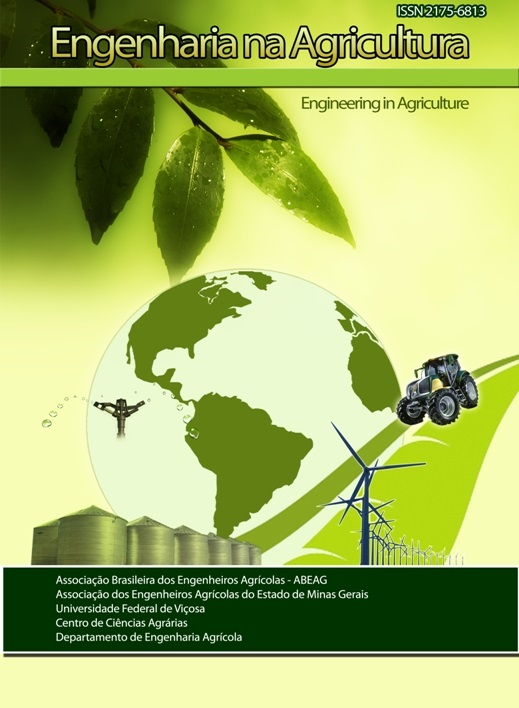Quality control of pneumatic spraying in tomato
DOI:
https://doi.org/10.13083/reveng.v29i1.8577Palavras-chave:
application technology, volumetric index, spectrum of droplets populationResumo
Tomato is a vegetable of great importance on the national scene. One of the problems of this culture is the great susceptibility to attack by pests and diseases. Thus, one of the most used practices is chemical control with phytosanitary products. The objective of this study was to evaluate the technical parameters of pneumatic spraying in tomato culture, through the study of the volumetric index and the population of spray droplets, aiming to reduce the spray volume, obtain the best efficiency and the social and environmental safety of the applications. The study of the droplet population was performed using water-sensitive paper labels. These labels were placed in the canopies of the tomato plants at three different heights and two positions. The sprays were made using a pneumatic backpack sprayer. After applying the syrup (dye + water), the water-sensitive paper labels were collected and subjected to the coverage and droplet density analyses by the computer program “CIR” version 1.5. The pneumatic sprayer proved to be efficient for the application of phytosanitary products in the tomato. The percentage of the target covered area ranged from 2.1 to 8.3% for volumetric indices as a function of thirds and positions, whereas the density of droplets ranged from 145.4 to 690.1 drops cm-2 for thirds and positions of the tomato plants evaluated. Finally, the volumetric index of 5 mL m-3, with a consequent spray volume of 50 L ha-1, met the parameters of a quality spray.
Downloads
Referências
BARTHELEMY, P.; BOISGOINTER, D.; JOUY, L.; LAJOUX, P. Choisir les outilis de pulverisation. Paris: Institut Technique des Céréales et des Fourrages. 160p.1990.
FOOD AND AGRICULTURE ORGANIZATION - FAOSTAT. Countries by commodity 2017. Disponível em: http://www.fao.org/faostat/en/#rankings/countries_by_commodity. Acesso em: 11 set. 2018.
HACHMANN, T.L.; ECHER, M.M.; DALASTRA, G.M.; VASCONCELOS, E.S.; GUIMARÃES, V. F. Cultivo do tomateiro sob diferentes espaçamentos entre plantas e diferentes níveis de desfolha das folhas basais. Bragantia, Campinas, v.73, n.4, p.399-406, 2014.
IBGE. Estatísticas. Produção Agrícola Municipal. Culturas temporárias e permanentes 2017. Disponível em: https://www.ibge.gov.br/estatisticasnovoportal/economicas/agricultura-e-pecuaria/9117-producao-agricola-municipal-culturastemporarias-e-permanentes.html?=&t=o. Acesso em: 09 jun.2018.
INTA. T&C CIR: Conteo y tipificación de impactos de pulverización. Versão 1.5. Buenos Aires: INTA, 2002.
ITAKO, A.T. Avaliação de produtos químicos no controle e na indução de mecanismos bioquímicos de resistência à mancha bacteriana (Xanthomonas perforans) do tomateiro. 2011. 104f. Tese (Doutorado em Agronomia) - Universidade Estadual Paulista Júlio Mesquita Filho. Faculdade de Ciências Agronômicas, Botucatu, 2011.
KÖPPEN, W. Climatologia - con un estudio de los climas de la tierra. México: Fondo de Cultura Economica, 478p. , 1948.
MEWES, W.L.C.; TEIXEIRA, M.M.; FERNANDES, H.C.; ZANÚNCIO. J.C.; TIBÚRCIO, R.A.S. Parâmetros característicos da pulverização pneumática em copas de árvores de eucalipto; Revista Árvore, Viçosa-MG, v.39, n.4, p.635-640, 2015.
PAIXÃO, G.P. Caracterização de pulverizadores para aplicação de defensivos agrícolas na cultura do café. 2016. 55f. Dissertação (Mestrado em Fitotecnia) - Universidade Federal de Viçosa, Viçosa, Minas Gerais, 2016.
PEREIRA-CARVALHO, R.C.; TOBAR, L.L.M.; DIANESE, E.C.; FONSECA, M.E.N.; BOITEUX, L.S. Melhoramento genético do tomateiro para resistência a doenças de etiologia viral: avanços e perspectivas. RAPP, v.22, p.280-361. 2014.
PENIDO, E.C.C.; TEIXEIRA, M.M.; FERNANDES, H.C.; MONTEIRO, P.; CECON, P.R. Desenvolvimento e avaliação de um pulverizador automotor controlado e monitorado remotamente em tomateiro. Revista Ciência Agronômica, Fortaleza, v.50, n.1, p.8-17, 2019.
SASAKI, R.S. Sistema eletrônico para captura de gotas visando aumentar a eficiência na pulverização eletrostática. 2011. 85f. Dissertação (Mestrado em Mecanização Agrícola) - Universidade Federal de Viçosa, Viçosa, Minas Gerais, 2011.
SUTTON, T.B.; UNRATH, C.R. Evaluation of the tree-row volume concept with density adjustments in relation to spray deposition in apple orchards. Plant Disease, v.68, n.6, p.480-484, 1984.
Downloads
Publicado
Como Citar
Edição
Seção
Licença
Copyright (c) 2020 REVISTA ENGENHARIA NA AGRICULTURA - REVENG

Este trabalho está licenciado sob uma licença Creative Commons Attribution-NonCommercial 4.0 International License.
Autores que publicam nesta revista concordam com os seguintes termos:
O(s) autor(es) autoriza(m) a publicação do texto na da revista;
O(s) autor(es) garantem que a contribuição é original e inédita e que não está em processo de avaliação em outra(s) revista(s);
A revista não se responsabiliza pelas opiniões, ideias e conceitos emitidos nos textos, por serem de inteira responsabilidade de seu(s) autor(es);
É reservado aos editores o direito de proceder a ajustes textuais e de adequação às normas da publicação.
A partir da submissão, o autor estará cedendo integralmente seus direitos patrimoniais da obra à publicação, permanecendo detentor de seus direitos morais (autoria e identificação na obra) e de acordo com a Licença Creative Commons, CC BY-NC.








 Esta obra está licenciada com uma Licença
Esta obra está licenciada com uma Licença 